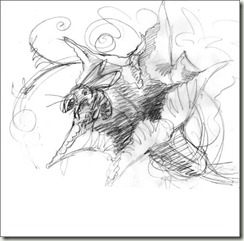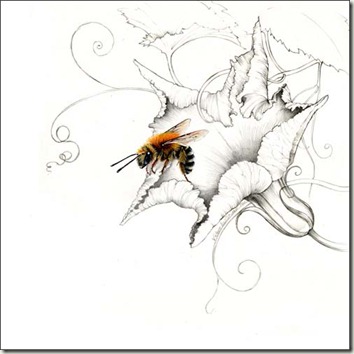This is going to be my last bee painting for a week or so.
We are about to move (yet again)and things will be a bit upside down, but this was one request I could not resist.
Joanna emailed me recently from Canada. She is fond of Squash bees.. how could you not be!
I had written about them briefly when I first learnt about the wonderful Long horned Eucerini bees back in 2009.
The Peponapis bees are in the same family and they are very–yes I am going to say it– they are very cute. Sadly we don’t have them here in the UK and although I saw the beautiful black Mellisodes bees on the squash flowers in Leu gardens in Orlando I did not see these little stripy charmers.
This photo is from an article in Science Daily, here about how good these bees are as pollinators. They apparently come out earlier in the day than honey bees, get on with lots of energetic pollination then sleep in the afternoon. 
Squash bee flying onto a squash flower. (Credit: Photo courtesy of Holly Prendeville, University of Nebraska)
Towards the end of her University degree in Agriculture Joanna published a paper commissioned by the North American Pollinator Protection Campaign about the decline of native pollinators.
She writes:
“Peponapis pruinosa, the Squash Bee holds a special place in my heart and I’ve been waiting for some time now with fingers crossed that you might paint this bee, but it recently occurred to me that I could easily contact you directly and make a request. This Squash bee is a solitary bee and the females make ground nests. The males spend their time in and about squash flowers – and they sleep there after the flowers close in the afternoon. I spent an interesting few weeks with a professor once spending late afternoons on a squash farm going from flower to flower, opening them up to count the resting bees. There is a mathematic correlation between the number of male bees in squash flowers in a given area to the number of females in the ground nests. By counting the bees, the professor was able to determine how many females were in the area.”
Don’t squash the squash bees.
I can’t think of a nicer afternoons’ occupation than opening up squash flowers to count these sweet little bees.
The males will overnight in the flowers and should you wish to see if you have any of them sheltering in your squash flowers you can give the closed flowers A VERY GENTLE squeeze.
A sleepy buzzing may be your reward … but don’t squash the squash bees.
Remember they are super pollinators for your curcubita crops.
I was of course delighted to draw a squash bee. Here is the stripy male poised on the edge of a squash flower (from a photograph of a Leu Gardens squash flower ) on the lookout, as ever, for a female.
A quick sketch to get the feel for the composition:
Peponapis pruniosa, The Squash Bee
Pencil and watercolour on Arches HP, 9 x 9 inches If you would like a print of this pretty bee drop me an email!














